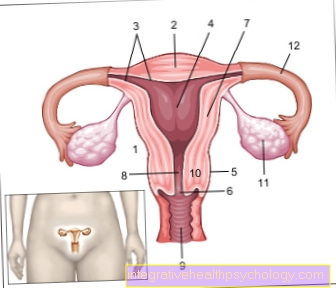Vitamin B9 - folic acid
to overview Vitamins
Occurrence and structure
Folic acid is found most abundantly in vegetable substances such as spinach, asparagus, leafy salads and cereals, as well as in animal liver. It consists of three building blocks: pteridic acid, benzoic acid and glutamate.
Vitamin B9 is also contained in: Beetroot, brocolli, carrots, asparagus, Brussels sprouts, egg yolks, tomatoes and nuts
Read more on the subject at: Foods with folic acid
function
Before folic acid (Vitamin B9) can fulfill its functions in the body, it must be activated. This is done using the (Dihydro)folate reductase, which it converts to active tetrahydrofolate (i.e. folic acid + four H atoms). Once activated, tetrahydrofolate (FH4) as a carrier of C1 groups, i.e. of one carbon atom each, to which various substituents can be attached. E.g. CH4 or CH3OH. Tetrahydrofolate is particularly important in the synthesis of dTMP (D.esoxy-Thymidinemonopphosphate), a building block for the DNA-Synthesis. This reaction is clinically very relevant because it is also passed through by tumor cells so that they can replicate their genetic material. In the Tumor therapy one therefore uses so-called Dihydrofolate reductase- Inhibitors which - as the name suggests - limit the function of dihydrofolate reductase to such an extent that it is no longer able to activate folic acid (vitamin B9) into tetrahydrofolate. For example dTMP, the DNA building block, is no longer produced and the DNA is no longer duplicated, which leads to the growth of the affected cells being arrested. These inhibiting Medication have a cytostatic effect (the growth of Tumor cells inhibiting). Methotrexate is one of those drugs.
Clinical intervention can also be made in the bacterial metabolism - as far as folic acid is concerned. In contrast to humans, bacteria can synthesize folic acid / vitamin B9 themselves. Humans use this to combat them by using sulfonamides to inhibit this synthesis of folic acid. This prevents the bacteria from multiplying. Sulfonamides are used as drugs for antibiotic therapy.
Deficiency symptoms
Since the folic acid / Vitamin B9 essential for cell reproduction (Mitosis), if there is a deficiency, it is mainly cells that often divide that suffer. This particularly applies to cells of the Bone marrow to, which among other things serve the blood formation. A folic acid deficiency leads to what is known as megaloblastic anemia (anemia = anemia, in which the red blood cells = Erythrocytes enlarged = megalo are)
It is essential to ensure adequate folic acid intake, especially in pregnant women, since folic acid deficiency is probably caused by neural tube defects (i.e. defects in the Brain or Backmarks of the child).
more on the subject Folic Acid During Pregnancy at our partner.
Overview of vitamins

Water-soluble (hydrophilic) vitamins:
- Vitamin B1 - thiamine
- Vitamin B2 - riboflavin
- Vitamin B3 - niacin
- Vitamin B5 - pantothenic acid
- Vitamin B6 - pyridoxal / pyridoxine / pyridoxamine
- Vitamin B7 - biotin
- Vitamin B9 - folic acid
- Vitamin B12 - Cobalamin
Fat-soluble (hydrophobic) vitamins:
- Vitamin A - retinol
- Vitamin C - ascorbic acid
- Vitamin D - calcitriol
- Vitamin E - tocopherol
- Vitamin K - phylloquinone / menaquinone





























